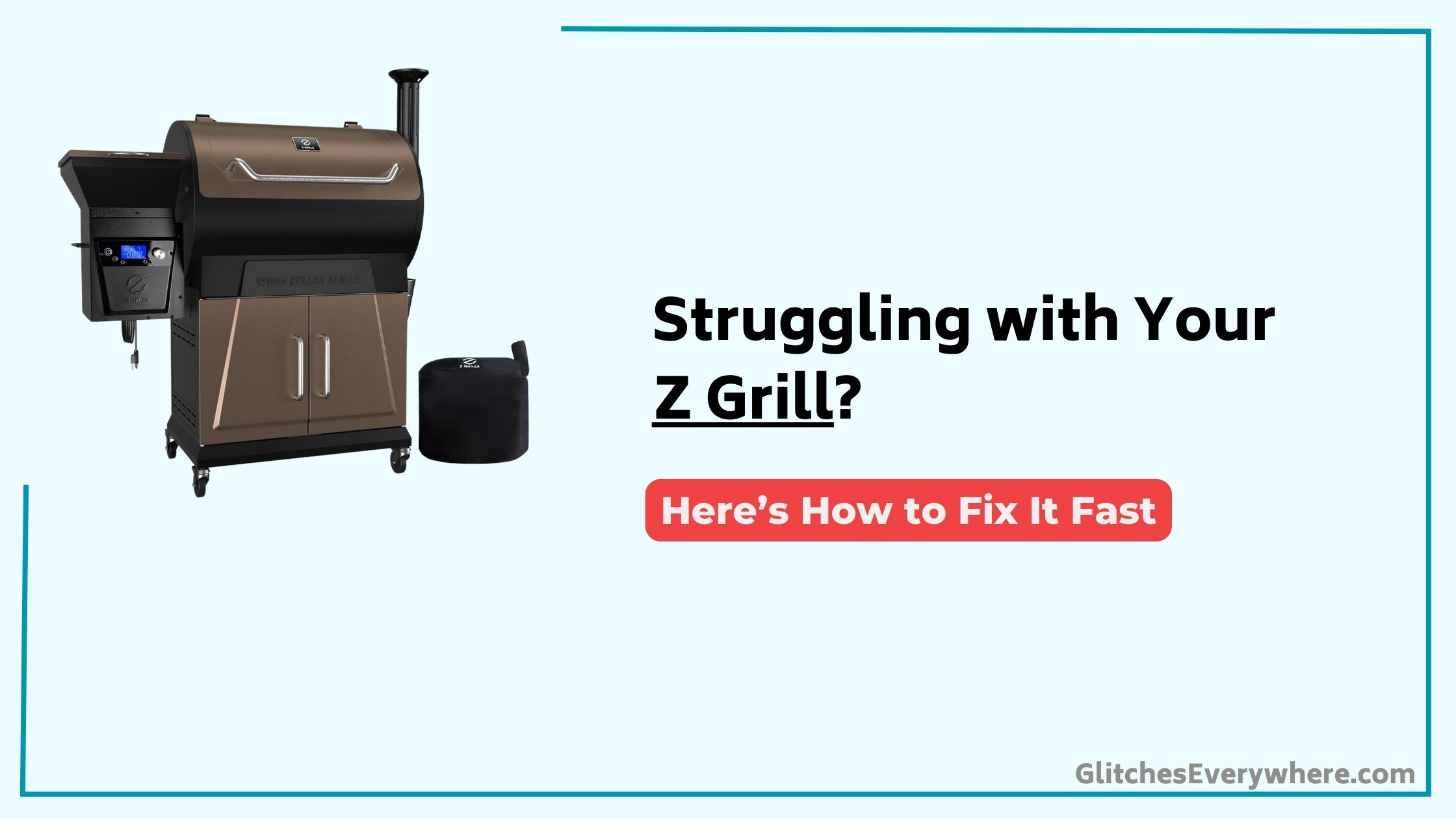The Z Grill is a great device, but like all electronics, it sometimes has its issues. If your Z Grill is not working, take a look at this troubleshooting guide.
We’ve collected answers to the most frequent reasons you’ll see Z Grill not working and explained them in plain language for easy troubleshooting.

Quick Fix
To troubleshoot a Z Grill, check the power source and ensure the grill is properly plugged in, verify the pellets are dry and the hopper is full, clean the firepot and auger, inspect the temperature sensor for damage, and confirm the fan and igniter are functioning correctly.
Common Issues With Your Z Grill
When you’re enjoying a backyard cookout with your Z Grill, the last thing you want is for it to malfunction.
But don’t worry, most issues with your pellet grill can be diagnosed and resolved through troubleshooting. Common problems include pellet grill flameouts, controller and power issues, fire-pot and grease issues, error messages, and airflow issues.
For instance, flameouts can be caused by bad wood pellets or ignition rod failure, while excessive smoke may indicate a fire-pot issue or moist pellets and ash.
Controller and Power Troubleshooting
When troubleshooting your Z Grill’s controller and power system, you’ll need to identify and address specific issues to get your grill up and running.
You’ll encounter error codes that require decoding, power shorts that need tracing, and fuses that may need replacement.
Error Code Meanings
Your Z Grill’s controller and power system are designed to provide you with a seamless grilling experience, but occasionally, error codes may appear, indicating a problem that needs attention.
When you see an error code, don’t panic! It’s usually a simple issue that can be resolved quickly.
Check your grill’s user manual or the manufacturer’s website for a list of error codes and their meanings. Common error codes include E1 for temperature sensor issues, E2 for faulty Heating Elements, and E3 for power supply problems.
Identify the error code, and you’ll be grilling again in no time.
Power Short Causes
Five common power short causes can bring your Z Grill to a halt, and understanding these issues is key to getting back to grilling.
When you’re not getting power to the grill, it’s essential to identify the root cause. You’ll need to inspect the electrical system and components to determine where the short is occurring.
- Loose or corroded connections can prevent power from reaching the grill’s components.
- A faulty or damaged power cord can interrupt the flow of power to the grill.
- A short circuit in the controller or other electrical components can also prevent the grill from receiving power.
Fuse Replacement Tips
If you’ve identified a power short as the root cause of your Z Grill’s malfunction, it’s likely that a blown fuse is the culprit.
To replace the fuse, you’ll need to access the controller’s internal components. Locate the fuse holder, typically marked with an “F” or “Fuse” label.
Remove the blown fuse and dispose of it properly. Install a replacement fuse with the same amperage rating, verifying it’s securely seated in the holder.
Reassemble the controller, and test your Z Grill to guarantee the issue is resolved. Remember to handle electrical components with care to avoid further damage or safety risks.
Fire-Pot and Grease Troubleshooting
When troubleshooting your Z Grill, you’ll want to inspect the fire-pot and grease tray for any issues that could be causing problems.
An overflowing fire-pot can be caused by ignition rod malfunctions or moist pellets and ash, while grease tray issues often stem from improper installation or food spills.
Fire-Pot Issues
How often have you been enjoying a perfect grill session only to encounter an issue with your fire-pot?
Fire-pot issues can be frustrating, but identifying the cause is key to resolving the problem.
- An ignition rod not working properly or moist pellets and ash accumulating in the fire-pot can cause issues.
- Excessive smoke can be caused by the fire going out and wood pellets accumulating in the fire-pot, or by temperature spikes.
To prevent these issues, regular cleaning and maintenance of the fire-pot is vital, and turning off the power to the grill can stop airflow to the fire and prevent further smoke.
Overflowing Fire-Pot Causes
Your Z Grill’s fire-pot overflowing can be a frustrating experience, especially when you’re in the middle of a grilling session.
It’s essential to identify the cause to prevent future occurrences. An ignition rod not working properly can lead to unburned pellets and ash accumulating in the fire-pot, causing it to overflow.
Using moist pellets can also contribute to this issue, as they don’t burn efficiently and produce excess ash.
Additionally, failure to clean the fire-pot regularly or not turning off the grill properly can lead to an overflowing fire-pot.
Grease Tray Problems
Proper grease tray maintenance is vital to guaranteeing your Z Grill operates smoothly, as it’s closely tied to the fire-pot’s performance.
A dirty or clogged grease tray can lead to poor airflow, reduced heat, and even fire hazards.
Make sure to regularly clean and inspect your grease tray to prevent these issues.
- Check for food residue and debris accumulation in the grease tray and clean it out after each use.
- Verify the grease tray is properly aligned and seated to prevent blockages.
- Consider replacing the grease tray if it’s damaged or excessively corroded to maintain peak performance.
Temperature Settings and Maintenance
The Z Grill’s temperature settings and maintenance are crucial aspects of its operation, as they directly impact the quality of your cooking results.
You must guarantee you’re achieving ideal temperatures to cook your food evenly and prevent overcooking or undercooking. Check your grill’s temperature gauge regularly to verify it’s within the recommended range.
Adjust the temperature settings as needed, and make sure the grill is preheated before cooking. Remember to clean the temperature probe regularly to guarantee precise readings.
Cleaning and Inspecting Your Z Grill
Cleaning and inspecting your Z Grill regularly is essential to maintaining its performance and longevity.
You’ll want to clean the firebox at least once a season, or more often with frequent use, to remove ash, debris, and grease buildup that can affect airflow and temperature control.
- Use a vacuum cleaner with a hose attachment, a stiff brush, and soapy water to remove ash and debris from the firebox and other components.
- Inspect seals around doors, lids, and vents for cracks or damage and replace them if necessary to guarantee proper airflow and temperature control.
- Check for rust on interior and exterior surfaces, as well as on screws and hardware components, and remove it with steel wool to prevent damage to the grill’s components.
Airflow Issues and Troubleshooting
Many airflow issues in your Z Grill can be traced back to a single culprit: ash and debris buildup.
When you don’t clean your grill regularly, ash and debris accumulate, restricting airflow and affecting temperature control. You’ll notice your grill struggling to reach desired temperatures or experiencing hotspots.
To troubleshoot, inspect your grill’s vents, chimney, and firebox for blockages. Clean out any debris and ash, guaranteeing a clear path for airflow. Additionally, check your grill’s airflow settings to verify they’re not restricting airflow.
Frequently Asked Questions
Why Is My Z Grill Not Working?
You’re wondering why your grill won’t turn on? First, check if it’s receiving power – verify the outlet’s working and the fuse hasn’t blown. If it has, identify the short’s cause before replacing it to prevent future issues.
Why Won’t My Z Grill Get up to Temperature?
When your grill won’t reach the desired temperature, you should first check the temperature sensors, ensuring they’re clean and free from debris, as faulty or dirty sensors can provide inaccurate readings, preventing your grill from reaching the set temperature.
How Do You Reset the Z Grill?
Imagine a fresh start, wiping the slate clean. To reset your grill, you’ll restore Factory Defaults by pressing and holding the “Ignite” and “Menu” buttons simultaneously for 10 seconds, then releasing; your grill will reboot, erasing all customized settings.
Why Does My Z Grill Keep Getting HER Code?
You’re getting recurring HER code error messages because your grill’s temperature sensor, controller, or firebox might be faulty, or you’re experiencing temperature spikes due to low-quality pellets, poor airflow, or a dirty grill, requiring immediate attention to prevent damage.
Conclusion
By following these troubleshooting steps, you’ll be able to identify and fix common issues with your Z Grill. For instance, a faulty temperature sensor can cause erratic temperature readings, but replacing it can get your grill back to peak performance. Take the case of John, who resolved his temperature control issue by cleaning the fire-pot and replacing the temperature sensor, and was back to grilling perfect steaks in no time. Regular maintenance and troubleshooting will guarantee your Z Grill continues to perform faultlessly.
Table of Contents

